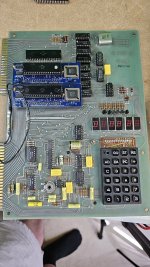I have never looked up supply issues in the past on 'HCT SOIC chips.
But there is a very interesting one, that is well documented and even in the manuals of some vintage computer boards from the late '70's, including the Matrox ALT-256 and ALT512 S-100 video cards.
Apparently, back in the late 1970's, due to the "explosion" of many manufacturers using 74LS IC's , many went out of stock a "shortage", at least in North America.
So they advised in the manuals, to fit plain 74 IC's in their place if the LS were not available (but the didn't say put up with the higher current consumption).
But here is the interesting thing in my view and it applies today:
When some very popular technology is surpassed, like LS74 replacing plain 74, it leaves behind many hundreds of thousands or millions of parts, like the plain 74 series TTL's. No "new" designer wants them, they are power hungry and "old hat". But oddly a wonderful silver lining.
The advantage is you can still get them.
A lot of modern IC's become obsolete at the drop of a hat. By the time you get something to the market, the part you used is now unobtainium.
So, I learned the "trick of using obsolete parts" where there is plenty of World stock. Say if it was 1985 I'd use the plain 74 chips not LS, but now I'd use DIL package HCT, because nobody else is using them.
You'd never guess what, a while back I made a project for a competition, where the prize money was funded by Australia's Dick Smith. My entry won the prize. It was to create an unbeatable Tic Tac Toe computer. Dick smith had made one back in the late 1950's using spare parts from a Telephone exchange.
I did it with now vintage DIL package 74HCT chips, for low power consumption and battery operation, also no CPU or clock, because cmos using static conditions has extremely low power, it was a "Static Computer".
The only "modern part" used in the design was a Hall Effect device, and before the article was published in Silicon Chip magazine, this new Hall device had become "obsolete" and a substitute had to be found (how ironic). All of the other "vintage devices" were still readily available in the many thousands:
www.worldphaco.com/uploads/THE%20STATIC%20TIC%20TAC%20TOE%20COMPUTER.pdf


